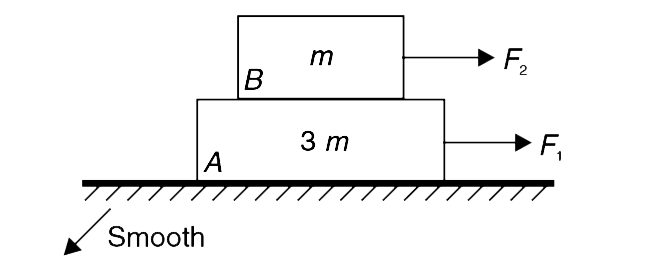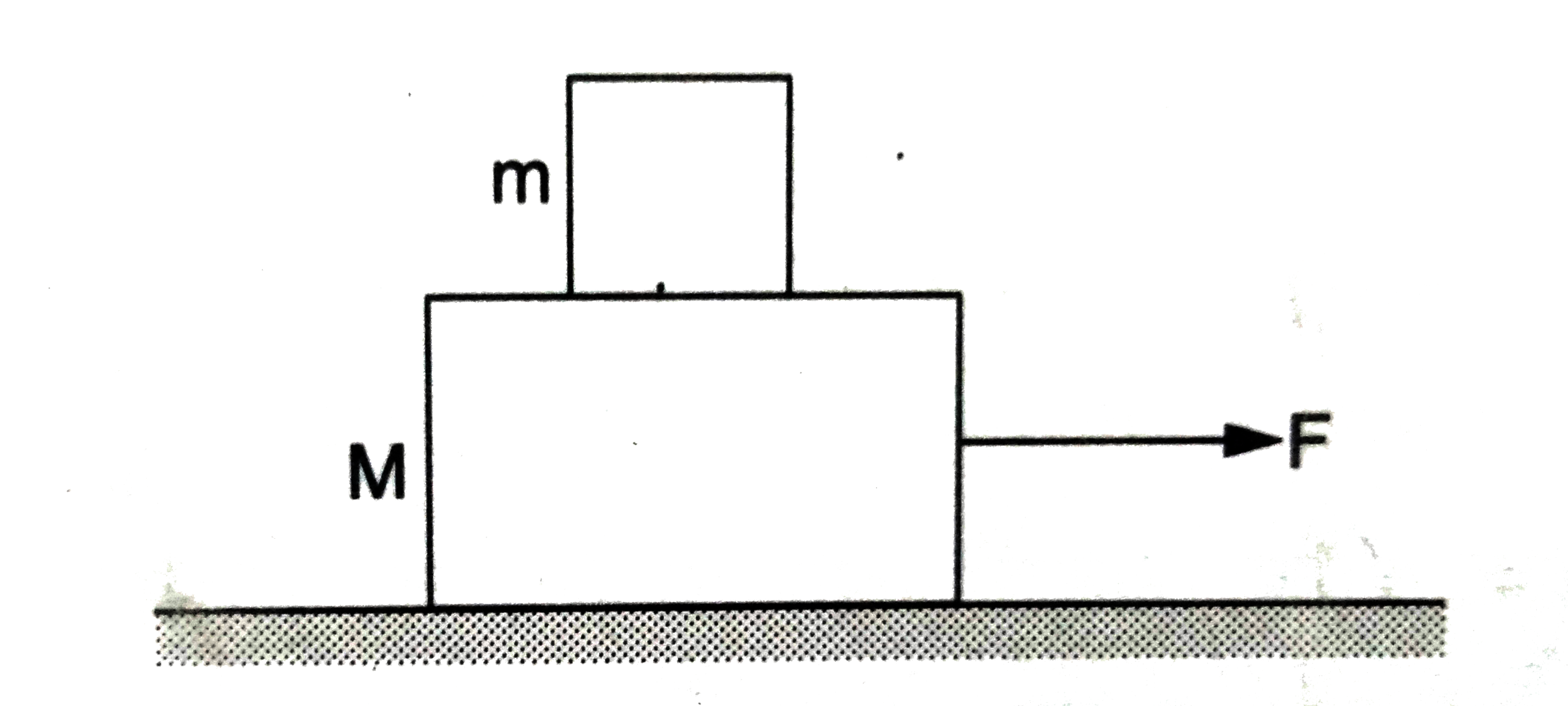The coefficient of static friction between the two blocks shown in figure is μ and the table is smooth. What maximum horizontal forced F can be applied to he block of mass M so that the block move together?
 Solution in Tamil
Solution in Tamil
When the maximum force F is applied, bothteh blocks move together towards right. The only horizontal force on the upper block of mass m is tht due to the friction by thelower block of mass M.Hence this force onm should be towads right. The force of friction on M by should be towards left by Newton's third law. As we are talking of the maximum possible force F that can be applied, the friction is limiting and hence f=μNwhereN is the normal force between the blocks.
consider the motion of m. The forces on m are ure.

a. mg downward by the earth (gravity),
b.N upward by the block M(normal force ) and
c. f=μN(friction) towards right by the block M.
In the vertical direction there is no acceleration. This gives
N=mg.........i
IN the horizontal direction, let the acceleration be a then
μN=ma
orμmg=ma
or, a=μg.......ii
Next consider the motion of M ure.

Teh forces on M are
a. Mg downward by the earth (gravity) ltbRgt N1 upward by the table (normal force),
c. N downward by m (normal force),
f=μN (friction) towards left by m and
e. F (aplied force) by the experimenter. The equation of motion is
F−μN=Ma
or, F-mu mg=M mug[Using i. and ii.]<br>or,F=mug(M+m).
Topper's Solved these Questions
- BOOK - HC VERMACHAPTER - FRICTIONEXERCISE - Questions for short Answer11videos
FRICTION
- BOOK - HC VERMACHAPTER - FRICTIONEXERCISE - Objective -110videos
FRICTION
- BOOK - HC VERMACHAPTER - FRICTIONEXERCISE - Exercises31videos
FRICTION
- BOOK - HC VERMACHAPTER - FLUID MECHANICSEXERCISE - All Questions96videos
FLUID MECHANICS
- BOOK - HC VERMACHAPTER - GRAVITATIONEXERCISE - Exercises39videos
GRAVITATION
Similar Questions
For most of the surfaces used in daily life, the frition coefficient is less than 1. Is it always necessary that the friction coefficient is less than 1?
02:20View SolutionIf the angle between force and displacement is acute then the work done is
05:33View SolutionA body slipping on a rough horizontal plane moves wioth a deceleationof 4.0ms. What is cofficient of kineic friction between the block and the plane?
13:22View SolutionWater is filled in a flask up to a height of 20 cm. The bottom of the flask is circular with radius 10 cm. If the atmospheric pressure is 1.01×105 Pa, find the force exerted by the water on the bottom. Take g=10ms−2 and density of water =1000 kgm^-3.
View SolutionTwo spherical balls of mass 10 hg are placed 10 cm apart. Find gravitational force of attraction between them
03:09View SolutionA block of mass m is kept on a horizontal table. If the static friction coefficient is μ., find the frictional force acting on the block.
06:04View SolutionFour block are arranged on a smooth horizontal surface as shown in figure .The masses of the blocks are given (see the fig ) The coefficient of static friction between the top and the bottom blocks is mu_(s) What is the maximum value of the horizontal force F applied to one of the bottom blocks as shown that makes all four block with the same acceleration ?
03:34View SolutionConsider the situation shown in the figure . The coefficient of friction between the blocks is mu . Find the minimum and the maximum force F that can be applied so that two blocks move together.
04:49View SolutionBlock B of mass m has been placed on block A of mass 3 m as shown. Block A rests on a smooth horizontal table. F1 is the maximum horizontal force that can be applied on the block A such that there is no slipping between the blocks. Similarly, F2 is the maximum horizontal force that can be applied on the block B so that the two blocks move together without slipping on each other. When F1andF2 both are applied together as shown in figure.

(a) Find the friction force acting between the blocks.
(b) Acceleration of the two blocks.
(c) If F2 is decreased a little, what will be direction of friction acting on B.05:50View SolutionCoefficient of static friction between the two blocks in Fig. 7.124 is mu and the table is frictionless . Maximum horizontal force which can be applied on the lower such that the blocks move together , is :
03:25View Solutionचित्र 9 .W4 में दिखये गए गुटकों के बीच घर्षण गुणांक μ है | टेबुल घर्षणरहित है|M द्रव्यमान वाले गुटके पर अधिकतम कितना क्षैतिज बल F लगाया जा सकता है ताकि दोनों गुटके साथ-साथ चल सकें?
 01:33View Solution
01:33View SolutionA block of mass m is lying on horizontal surface of coefficient of friction mu. A force is applied to the block at an angle theta with the horizontal. The block will move with a minimum force F if
View SolutionA wooden block of mass m resting on a rough horizontal table (coefficient of friction = mu ) is pulled by a force F as shown in figure.The acceleration of the block moving horizontally is :
06:54View SolutionTwo blocks A and B are lying on the table as shown in the figure. The coefficient of friciton between block A and block B is mu . The coefficient of friction between block B and ground also mu . An external force F is applied in the direction shown. The maximum value of the force F that can be applied without moving the blocks.
03:45View SolutionA horizontal force of 20 N is applied to a block of mass 4 kg resting on a rough horizontal table. If the block does not move on the table, how much frictional force the table is applying on the block. What can be said about the coefficient of static friction between the block and the table? Take g=10m/s^2 .
04:56View SolutionA block of mass m is kept on a horizontal table. If the static friction coefficient is μ., find the frictional force acting on the block.
06:26View Solution

